Why Doesn’t Fullmetal Alchemist: Brotherhood Look Great On Blu-ray?
By Marc | May 11th, 2010
After looking at my review of Brotherhood on Blu-ray, some people may be wondering… why doesn’t the Blu-ray look pristine? After all, it is a brand new series, shouldn’t it look glorious in 1080p on Blu-ray? Funi even gave it the first ‘Native HD’ tag they’ve ever labeled with. Is it really an upscale and they lied?
Let’s start with that. No, it seems very unlikely that Funimation lied. But then why doesn’t it look good? That is what this article will explain.
For this article, I recommend clicking an image to see it at the full resolution. All images in this article are lossless PNG files since image quality is of importance for this article (and due to it being based more on quality than on color there are no easy to view image comparisons, you’ll have to open the images and compare them.)
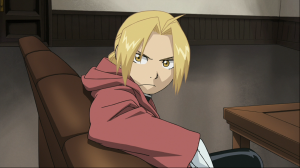
As you can see above, Fullmetal Alchemist: Brotherhood on Blu-ray doesn’t look like we expect it to. So here is an explanation of why that is.
To start with, let us look at Brotherhood as it is stored on its DVD counterpart.
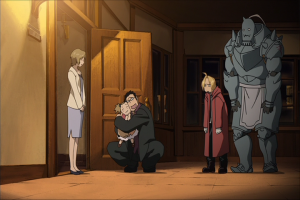

On DVD video is stored at 720×480 (480p.) When someone is talking about an upscale, it is likely made from an image that looks exactly like this. When you use an upscaling player these images are upscaled, a method of resampling the image and attempting to fill in problem areas by figuring out the colors around them to attempt to make it look its best at 1080p (based on your TV it may upscale to 720p or 1080i, but 1080p is the example we are using since it is Blu-ray’s resolution.) When a company does an upscale, in most cases at least, they use an image that looks very close, but won’t have MPEG2 encoding artifacts (MPEG2 being the type of video all DVDs are.)
You may be wondering why those images look incorrect. It’s because they actually have a digital ‘flag’ that tells your player to stretch them to the proper aspect ratio. Here is a look at both caps stretched to be their proper aspect ratio.


Others may be wondering what any of this actually has to do with the Blu-rays. Just giving background information and showing what they look like on the normal DVD as an example.
Having looked at the DVDs it is time to take a proper look at the same frames taken from the Blu-ray.
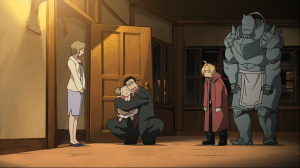

Once again, doesn’t look so great. There is stuttering and some pixelation, not to mention edge enhancement. Details and some colors also don’t appear as vivid as you might expect. So once again, the question is why?
Based on looking at information both from its TV run in Japan and the Japanese Blu-rays, it appears it is because Brotherhood was actually animated at 540p.
As for why it was animated at 540p, no idea. There are many potential explanations: a lack of time or limited budget, among other possible reasons. Let’s figure out what the animation being 540p means overall.
It means that the Blu-ray doesn’t have the same level of detail that 1080p or 720p animation would. It looks cleaner and has a bit more detail than the normal DVD does though.
The 540p number was found during the HDTV airing of Brotherhood in Japan and checked again when it came out on Blu-ray. Based on playing with screencaps from the American Blu-ray, the same appears to be true here as well.
So what happens when we take the Blu-ray, and downscale it down to 540p?
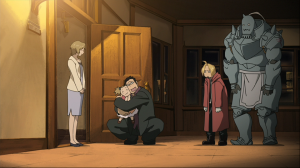

Outside of a bit of edge enhancement and a few other things introduced seemingly during the upscale process from 540 to 1080, it looks nearly pristine. So yeah, Brotherhood is 540p.
But Funimation labeled it Native HD… in fact, this is the first time they’ve added a label to indicate if the show is native or upscaled, so why does it say native when it is an upscale (not an upscale from DVD resolution, but a bit higher.)
It is because as far as anyone is concerned, it is 1080. It aired in 1080i on Japanese TV and the Japanese Blu-rays were 1080p. Funimation was likely given 1080p masters from Japan and may have had no knowledge of any of this (conjecture on my part) and even if they did, if the Japanese licensor says these are the 1080p masters, can’t really argue with them that much.
So Brotherhood’s 1080p Blu-rays are actually based on 1080p masters that are based on 540p masters…
But how do we know for sure Funimation didn’t just upscale masters themselves and slap the native tag on there to mislead people?
Let’s compare the Japanese Blu-ray with the American Blu-ray with a different screen cap than the ones I’ve been using.
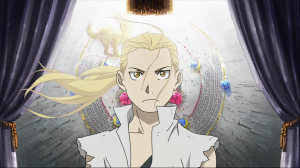

The top is from the Japanese Blu-ray, the bottom is the American Blu-ray. They are effectively identical. The only noticeable difference is the American Blu-ray is brighter. Older (specifically analog) American and Japanese TVs have slightly different black levels (about a 10% difference.) Why is it still consistently done when Blu-ray and nearly all modern sets are digital nowadays and (as far as I’m aware) that brightness difference doesn’t exist anymore… I’m not the guy to ask about that because I have absolutely no idea.
The story of Fullmetal Alchemist: Brotherhood’s resolution ended up being a slightly more complex one than many people would imagine. Not technically HD, but not a straight upscale from a 480 master.
You have to admit it is ironic and a bit funny that after many of us asked Funimation to label their Blu-rays that the first disk to get a label would have an odd twist to it. Funimation definitely didn’t lie, but in this specific case, the contents aren’t what many of us would consider ‘Native HD’ either. Although even that has become murky. Quite a few HD games aren’t even 720p. The recent ‘Call of Duty’ games are all 600p, Halo 3 is 640p, and the recent Ghostbusters video game was 720p on Xbox 360 but 576p on Playstation 3. And all of those are labeled as HD games. This is one people are going to have to decide yourself.
Do you consider Brotherhood HD or not?
If you’d like to read a review of the Blu-ray of Fullmetal Alchemist: Brotherhood, we actually have one (it is actually what ended up leading to this article.) Feel free to have a read: Fullmetal Alchemist: Brotherhood- Part One (Blu-ray), Early Review
Fullmetal Alchemist – © HIROMU ARAKAWA/SQUARE ENIX, MBS, ANX, BONES, dentsu 2004. Licensed by FUNimation® Productions, Ltd. All Rights Reserved.














Pingback: Otaku in Review Podcast – PAL Has Nothing To Do With It | JanaiBlog
Pingback: Otaku in Review Podcast – PAL Has Nothing To Do With It | JanaiBlog Archive
Pingback: Analyzing What Good Directing in Anime Looks Like via Zankyou no Terror Episode 1 | My Sword Is Unbelievably Dull